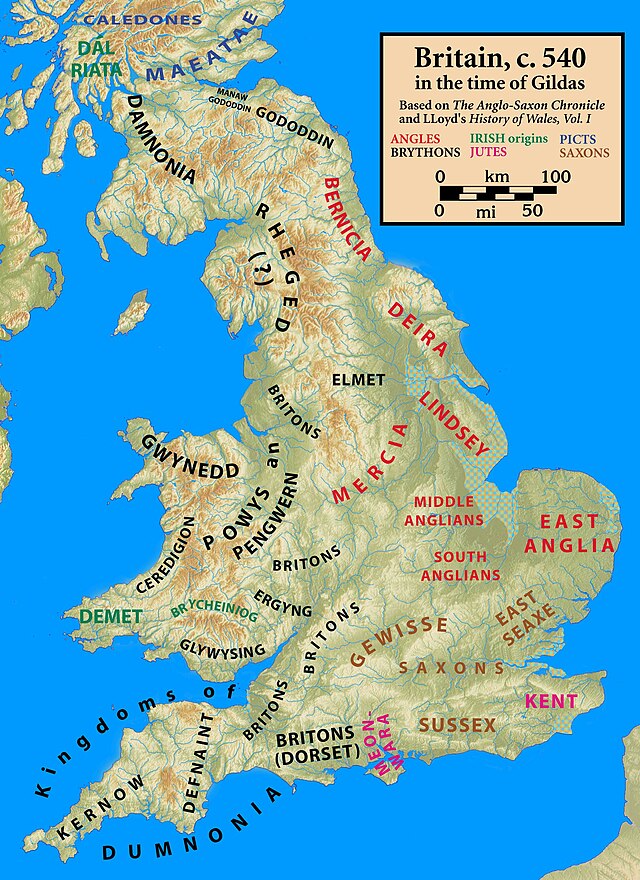热门问题
时间线
聊天
视角
后罗马不列颠
来自维基百科,自由的百科全书
Remove ads
后罗马不列颠(英语:Sub-Roman Britain)是指罗马统治结束至盎格鲁-撒克逊人前来定居之前的古典时代晚期大不列颠。该术语最初用于描述在公元5-6世纪遗址中发现的考古遗迹,这些遗迹显示罗马帝国统治时期当地瓷器制造业走向衰落。现在,该术语被用来描述从407年君士坦丁三世召回罗马军队至高卢到577年迪勒姆战役结束期间的大不列颠。

名词含义
后罗马不列颠的时期是指在罗马治下不列颠部分地区的历史,在传统上涵盖了从410年罗马帝国撤出不列颠直到597年坎特伯雷的奥古斯丁的到达。[1] 该时期确切的结束日期反复多变,后罗马文化一直存续在北英格兰一带直到633年布里甘特人的雷格德王国通过联姻与盎格鲁-撒克逊人的诺森布里亚王国合并,后罗马文化更长久地存续在不列颠西部,特别是康和郡、金巴伦和威尔士。
这一时期引起了学术界和大众的大量争论,部分原因是缺少文字记录资料。“后罗马”和“后罗马”这些术语同样地适用于旧有罗马行省的不列颠尼亚,即福斯河–克莱德河界线以南的不列颠。哈德良长城与福斯河–克来德河界线之间地区的历史与威尔士非常相似 (参见: 雷格德、伯尼西亚、戈多丁和斯特拉斯克莱德王国)。界线以北是人口稀少的地区包括米阿塔人的王国 (位置在今天的安格斯 (苏格兰)),达尔里阿达王国 (在今日的亚皆老郡),以及圣高隆曾造访过在延文礼士附近一个名叫“kaer”(城堡)的王国。罗马人将这些人统称为”皮克特人”,意思是“被彩绘者”。
古典时代晚期这一术语意味着一个更广阔的时代背景,在学术界得到了更多的使用,尤其是在研究整个后西罗马常见的古典文化转变时。如果需要强调与接着的时期的连续性,该时期也可以被认为是中世纪前期的一部分。通俗(和一些学术)的著作使用了一系列更具戏剧性的名称来描述这一时期:黑暗时代,布立吞时代,僭主时代或亚瑟王时代[2]
Remove ads
书面记述
现存后罗马不列颠时期可用的文字记录资料非常稀少,虽然有相当多出于该时代晚期的记录可能与之相关。而许多现有的资料仅涉及5世纪最初的几十年。这些资料来源能够有效地分类为不列颠与欧洲大陆的,以及是同代和非同代的。
两个主要同时代的不列颠史料存在于:圣博德的《Confessio》和吉尔达斯的著作《不列颠的毁灭》。[3] 圣博德的Confessio与他给斯特拉斯克莱德王国国王Ceretic Guletic的书信中展现了不列颠的生活面貌,而他其后从那里被绑架到爱尔兰。对于当时爱尔兰基督教信仰有显著重要的地位。吉尔达斯的著作资料是最接近后罗马不列颠历史的,但在使用它时存在许多问题。这些文献描绘的不列颠历史是依照他和他的读者所理解。虽然确实存在一些是这一时期的其他文献,例如吉尔达斯修道院生活的书信,但它们与不列颠的历史没有直接关系。吉尔达斯的《不列颠的毁灭》(De Excidio)是一部哀歌: 这一部作品被写成一场论战,从而警告当代统治者不要犯罪,通过历史和圣经的例证,邪恶统治者总是受到上帝的惩罚–就不列颠而言,上帝通过撒克逊侵略者降下毁灭性的天谴。《不列颠的毁灭》在描述历史上的一部分是很短的,取材显然是根据吉尔达斯的主意为目的而选。该著作没有给出确实的日期,以及一些细节,比如那些关于哈德良长城和安东尼长城显然是错误的。然而,吉尔达斯确实让我们深入了解他写作时存在的一些王国,以及受过教育的修士如何理解盎格鲁-撒克逊人和凯尔特布立吞人之间发展起来的局势。
还有更多来源于欧陆的当代资料提及不列颠,尽管这些资料都是高度不确定的。最著名的是所谓的“霍诺留敕令”,西罗马皇帝霍诺留警告不列颠的罗马公社在防务上需要自我保护。在意大利南部的讨论中时发现到第一次提及到该敕令的,是由6世纪的拜占庭学者佐西姆斯所撰写; 但内容没有进一步提及到不列颠,这导致了现代学术界稍微带出,尽管不是全部认为,该敕令不适用于不列颠,而是给意大利的布鲁提乌姆。[4][5][6]《452年的高卢编年史》和 《511年的高卢编年史》皆表示罗马人贸然地“放弃不列颠并落入了撒克逊人的手中”,并提供了有关欧塞尔的圣日耳曼努斯及其造访不列颠的资讯,尽管该文本一再受到了相当大的学术的解构。[7] 另一位6世纪的拜占庭作家普罗科匹厄斯的著作提到了不列颠,尽管这些资料的准确性尚不确定。
数目众多的后期著作声称提供了该时期准确的记述。第一个尝试这样做的是修士比德,他大量地运用吉尔达斯的后罗马不列颠的记述著书于8世纪的《英吉利教会史 》中 (成书于731年) ,尽管他试图为吉尔达斯描述的事件提供日期。这部著作是从反布立吞人的角度写的。后期的资料如《不列颠人的历史 》通常认为是威尔士编年史家内尼厄斯的著作,《盎格鲁-撒克逊编年史》(一部再次从非布立吞人的角度撰写的史书,而是基于威塞克斯的资料)和《威尔士编年史》,内容都笼罩在神话当中,只能谨慎地用作这一时期的证据。[8] 还有一些似乎可以追溯到6世纪的文献提供,如威尔士诗歌 (吟游诗人塔利埃辛与阿内林)和兰达夫之书。
在诺曼征服英格兰后,有许多书籍笔下介绍后罗马不列颠时期的历史。这些都受到了蒙茅斯谢菲的不列颠诸王史中虚构记述的影响。因此,该著作只能以展示传说是如何发展的来看待。直到现代,人们才对这一时期从事了认真的研究。
后来的凯尔特圣徒的生活记述虽然通常都不太可靠,但确实提供了一些关于后罗马不列颠生活的见识。例如圣塔修斯造访邻近切普斯托一座破旧但仍然有人居住的罗马别墅的记述 (大概在现今的朴茨克韦特。[9]) 685年卡莱尔的罗马废墟在圣卡斯伯特的生活记述中亦有所描述。[10]
Remove ads
考古证据
考古学为这一时期提供了进一步的证据,在一些证据上间接表明到罗马城镇人口减少以及乡间别墅和庄园组织的发展已经在4世纪时发生。[11]
不列颠在5世纪和6世纪时的特点是城镇生活明显的中断,除了伦蒂尼恩、埃伯拉肯、坎特伯雷和罗克斯特等少数几个地点外,[12] [13] 但以上几个地点主教区的中断也表明罗马城镇生活正在衰落。
以大约五百个考古遗址为代表的罗马别墅系统也没有在该时代幸存下来。与高卢不同,在不列颠,没有一个列名的别墅幸存到日耳曼人时期。然而,在切德沃思,新建筑工程仍在继续:2020年发现的28号房间的马赛克是在5世纪中叶设计和建造。[14][15][16]
石造建筑在后罗马不列颠时期逐渐走到了尽头。而建筑物的耐用建造材料相比罗马时期较少。[17] 这一时期的胸针、陶器和武器幸存下来。对土葬和火葬以及与之相关的陪葬品的研究,为扩大对这一时期文化本身的理解做出了很大贡献。考古学已经展示出一些与罗马教育、与地中海的贸易以及凯尔特艺术等一连串的证据。2003年于西威尔士的考古挖掘中寻找到由圣伊尔图德(St Illtud)于6世纪初创立的中世纪前期的修道院和学校的证据,据说是建于约1100年诺曼时期的St Illtyd教堂的前身。[18]
定居点的发掘揭示了后罗马不列颠社会结构可能发生的变化,以及不列颠人的生活上有多大程度在某些地区保持不变并延续到中世纪前期。丘堡,古罗马兵营和修道院已被挖掘出来。在城镇方面的考古工作尤为重要。丘堡的考古已经展示出整修的证据,以及海外贸易在该时期的证据。最早的重大发掘之一是1939年在廷塔哲。Ralegh Radford在这里挖出了的矩形结构和许多地中海陶器。该建筑物最初被解释为修道院,但其后被认为是一座壮丽的堡垒与贸易据点。另一个重要的发掘是1963年Leslie Alcock在迪纳斯波伊斯,它显示了金属加工的证据。此外Alcock在1995年领导了南吉百利的发掘工作。现时还有许多其他遗址显示了在后罗马时期有人居住,包括博度斯和撒克逊海岸堡垒。田地系统和环境考古学方面的工作同时凸显了农业实施在此期间的持续和变化。 [19] 日耳曼人的葬礼已经在怀特岛郡的Bowcombe和Gatcombe被考古学所证实,[20] 而日期至少比历史资料建议的早了50年,与此同时西罗马皇帝霍诺留于418年将阿基坦高卢的土地授予西哥特人。

虽然放射性碳定年法可以提供粗略的估算,这还不足以将考古发现与历史事件联系起来。而树轮年代学则取决于是否存在合适的木块样本。[21] 硬币通常是最有用来确定年代的工具,但据信在5世纪初之后,没有新铸造的硬币流通并进入不列颠。
有考古证据表明盎格鲁-撒克逊人和凯尔特布立吞人生活在同一地点。例如,在和域郡惠斯伯顿的墓地,可以看到一个布立吞人家庭在一段很长的时间内采用盎格鲁-撒克逊文化。[22]
罗马统治的终结
终结罗马在不列颠尼亚统治的直接原因似乎是罗马帝国的贵族强豪与罗马将军斯提里科之间的权力斗争。[23] 为了保护意大利免受西哥德人的入侵,斯提里科严重消耗了保卫日耳曼长城的罗马军力。在406年的夏天,不列颠发生兵变, [24] 这导致几个篡位者接连被推举为“皇帝”,[25] 并宣布反抗执政的皇帝。其中最后一位篡位者君士坦丁三世,带走了所有不列颠尼亚驻军,渡过海峡到博诺尼亚,从而剥夺了该省的任何第一线军事防护。罗马高卢驻军 (现今的法国) 表态支持不列颠篡位者,跟随其后是希斯帕尼亚 (现今的西班牙) 的大部分驻军。406年12月31日,汪达尔人、勃艮第人、阿兰人和斯维比人跨越莱茵河占领了“日耳曼长城”。
与此同时,蛮族于408年袭击了不列颠,但这些袭击似乎都被击退。于410年后,西罗马皇帝霍诺留似乎写信命令不列颠各城市需要自我保护。尽管这有时会引起争议。[26][27][28] 日耳曼劫掠者从5世纪中叶开始在不列颠东部河谷定居。[29] 其后内战似乎已经爆发,这些内战被后世学者解释为亲罗马和独立聚落之间,或“国教会”和伯拉纠主义党派之间(Myres 1965年,Morris 1965年),农民和地主之间的阶级斗争(Thompson 1977年,Wood 1984年),或是一场城市精英的政变(Snyder 1988年)。Stuart Laycock在2008年的著作《不列颠尼亚失败的国家Britannia the Failed State》探究一个新近的观点认为不列颠根据各部落本身,猛烈地分裂成一个个不列颠人的王国; 猛烈地分裂是有争议的,但显然大多数不列颠尼亚罗马公社逐渐转变为王国。乡郊似乎继续著和以前一样的生活,而欧塞尔的圣日耳曼努斯造访不列颠时描述城镇的生活规模缩小。王权的长期斗争取代了过去罗马行省中央管治的方式。
吉尔达斯认为军阀沃蒂根召开了一个“议会”以寻找应对蛮族威胁的方法。议会按照罗马的惯例选择雇用撒克逊雇佣兵。一段时间过后,这些雇佣兵调转枪头反对不列颠人并劫掠城镇。据说不列颠人领袖安布罗休斯·奥理安在很长一段时间内在许多战役中与他们作战。巴顿山战役大约在490年这一时期将近结束时发生,后来的资料来源声称这场战役是亚瑟王赢得的,尽管吉尔达斯没有在著作中透露他的身份。此役之后,迎来一段漫长的和平时期。不列颠人似乎已经控制了英格兰和威尔士,边界大致是从约克到般尼茅夫以西一带。日耳曼的撒克逊人控制了从东约克郡到林肯郡,也许还有诺定咸郡,再到东盎格利亚和东南英格兰一带的弧形东部地区。
吉尔达斯大约在540年用拉丁文写成描述了不列颠历史的著作,但前半部分(其他可用资料来源)极度混乱。他严词批评了不列颠西部的五位统治者的罪孽—顿诺尼亚的君士坦丁、奥勒留·卡尼努斯(Aurelius Caninus)、德梅泰的沃蒂波尔(Vortipor)、库内格拉苏斯(Cuneglasus)和马格洛库努斯(Maglocunus)(或称为Mailcun或后来拼写为格温内斯的迈尔贡)。在著作中他还攻击了不列颠的教士。他提供有关不列颠的饮食、服饰和娱乐的资讯。他写道,布立吞人被杀、移居或被奴役,但没有给出数字。
在6世纪晚期,撒克逊人再一次出现了扩张时期,从日后统治威塞克斯王国的王族于552年占领威尔特郡的Searoburh (现今的老沙伦)为起点,扩张包括在577年迪勒姆战役后进入中南至西南部的科兹窝地区,虽然对《盎格鲁-撒克逊编年史》中这一时期的条目的准确性被受质疑。但现代作家经常在没有明确证据的情况下,说这些征服将西南英格兰的布立吞人(后来称为西威尔士人)与威尔士的布立吞人分割开。(就在讨论该时期之后,于611 年的车士打战役可能已经将后者与英格兰北部分割开。)但直到570年代,布立吞人仍然控制着英格兰和威尔士大约一半的地区。
Remove ads
王国

存在于该时代某个时期的各个不同的不列颠人王国。一部分王国更改了名称,部分被其他吞并。并非所有王国的名字和其政治发展细节都为人所知,尤其是在东南部,罗马时代遗留下来的一些权力组织可能在一段时间内继续负责某些地区。有时由一个统治者作为霸主将一些王国联合起来,而战争则在其他王国彼此之间发生。边界很可能在此期间已经变动。主要的王国有:
- 布莱尼奇王国 – 现今的诺森伯兰郡; 最终被伯尼西亚的盎格鲁人占领
- 顿诺尼亚王国 – 现今的西南英格兰,康和郡和德云郡的大部分地区
- 达费德王国 – 西南威尔士
- 埃尔京王国 – 禧福郡西南部,蒙茅斯郡北部和告罗士打郡的迪恩森林
- 格温特王国,布雷切尼奥格王国和格利维斯王国 – 南威尔士
- 波伊斯王国 – 威尔士中部
- 格温内斯王国 – 北威尔士
- 爱密特王国 – 约克郡西南部
- 雷格德王国 – 金巴伦和兰开夏
- 埃布劳克王国 – 约克和北约克郡
- 斯特拉斯克莱德王国 – (900年–1100年)在西南部苏格兰、坎伯兰、威斯摩兰
- 戈多丁王国 – 以洛锡安的特拉普兰为中心
部分地区落入盎格鲁或撒克逊部落首领的统治之下,后来成为王国:
- 伯尼西亚 – 伯尼西亚的盎格鲁人王国,然后与德伊勒一起成为诺森布里亚王国
- 德伊勒 – 德伊勒的盎格鲁人王国,在与伯尼西亚合并成为诺森布里亚前(东约克郡)
- 东盎格利亚王国 – 包括沙福郡和诺福克郡
- 肯特王国
- 赫威赛 – 除了迪恩森林外,现今告罗士打郡的大部分地区与牛津郡西部
- 萨塞克斯王国 – 包括黑斯廷加的定居点,其中可能包含来自朱特人族群
- 埃塞克斯王国 – 包括中撒克逊与现今的舒梨郡
- 威塞克斯王国 – 由泰晤士河谷上游地区构成,以及合并了在米恩河谷的朱特人定居点地区和围绕现今的修咸顿一带 (包括怀特岛郡)
- 麦西亚王国 – 以雷普顿为中心
- 中盎格鲁 – 现今的东密德兰,其后并入麦西亚
- 诺森布里亚王国 – 由伯尼西亚与德伊勒合并构成
- 维特瓦拉
Remove ads
更多阅读
Wikiwand - on
Seamless Wikipedia browsing. On steroids.
Remove ads
